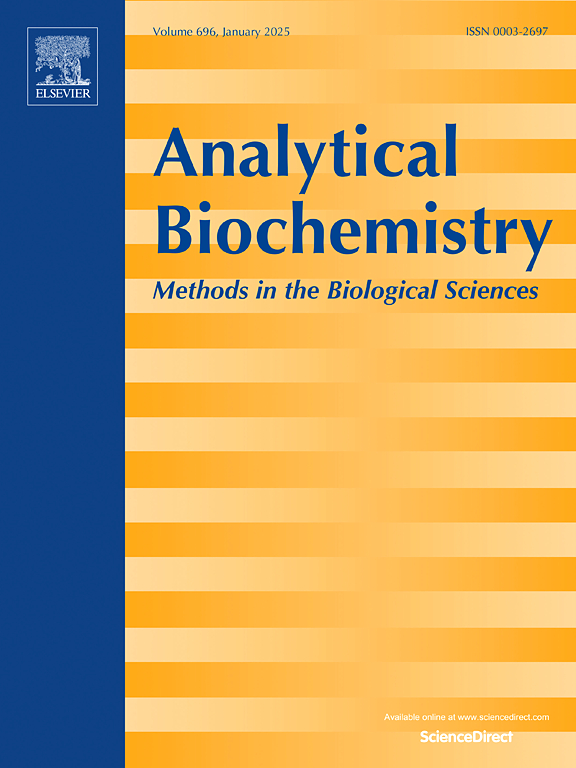Development of Pt/Au/PPy-COOH multisegmental nanowires modified label-free impedimetric immunosensor to determine mucin 1 (MUC1)
IF 2.5
4区 生物学
Q2 BIOCHEMICAL RESEARCH METHODS
引用次数: 0
Abstract
In this study, a label-free nanowire-based impedimetric immunosensor was developed for the purpose of determining cancer biomarkers mucin 1 (MUC1). Nanowires were selected for sensor modification due to their high catalytic properties and high enzyme loading capacity. The synthesis, characterization, and application of Pt/Au/PPy-COOH nanowires to modify SPE electrodes were conducted. The nanowire-based immunosensors developed as a result of this research demonstrated a broad linear working range for MUC1 (20–3000 fg/mL), a low LOD value (0.244 fg/mL), and a low LOQ value (0.815 fg/mL). The nanowire-based immunosensor exhibited several notable characteristics. Firstly, it demonstrated excellent reproducibility, selectivity, and long-term stability. Furthermore, it demonstrated notable regenerative capabilities. It is noteworthy that the sensor exhibited the capability to detect MUC1 in commercial human serum samples, even in the presence of interfering agents. The affordability, simplicity, and expeditious analysis of nanowire-based immunosensors render them more appealing than alternative commercial kits. Consequently, these sensors hold considerable promise for clinical applications.

Pt/Au/ py - cooh多段纳米线修饰无标记阻抗免疫传感器mucin 1的研制
在这项研究中,开发了一种基于无标记纳米线的阻抗免疫传感器,用于检测癌症生物标志物mucin 1 (MUC1)。由于纳米线具有高催化性能和高酶载量,因此选择纳米线进行传感器修饰。研究了Pt/Au/ py - cooh纳米线的合成、表征及其在固相萃取电极中的应用。研究结果表明,基于纳米线的免疫传感器对MUC1具有宽的线性工作范围(20-3000 fg/mL),低LOD值(0.244 fg/mL)和低LOQ值(0.815 fg/mL)。基于纳米线的免疫传感器具有几个显著的特征。首先,该方法具有良好的重复性、选择性和长期稳定性。此外,它还显示出显著的再生能力。值得注意的是,该传感器显示出在商业人类血清样品中检测MUC1的能力,即使在存在干扰剂的情况下。纳米线免疫传感器的可负担性、简单性和快速分析使其比其他商业试剂盒更具吸引力。因此,这些传感器具有相当大的临床应用前景。
本文章由计算机程序翻译,如有差异,请以英文原文为准。
求助全文
约1分钟内获得全文
求助全文
来源期刊

Analytical biochemistry
生物-分析化学
CiteScore
5.70
自引率
0.00%
发文量
283
审稿时长
44 days
期刊介绍:
The journal''s title Analytical Biochemistry: Methods in the Biological Sciences declares its broad scope: methods for the basic biological sciences that include biochemistry, molecular genetics, cell biology, proteomics, immunology, bioinformatics and wherever the frontiers of research take the field.
The emphasis is on methods from the strictly analytical to the more preparative that would include novel approaches to protein purification as well as improvements in cell and organ culture. The actual techniques are equally inclusive ranging from aptamers to zymology.
The journal has been particularly active in:
-Analytical techniques for biological molecules-
Aptamer selection and utilization-
Biosensors-
Chromatography-
Cloning, sequencing and mutagenesis-
Electrochemical methods-
Electrophoresis-
Enzyme characterization methods-
Immunological approaches-
Mass spectrometry of proteins and nucleic acids-
Metabolomics-
Nano level techniques-
Optical spectroscopy in all its forms.
The journal is reluctant to include most drug and strictly clinical studies as there are more suitable publication platforms for these types of papers.
 求助内容:
求助内容: 应助结果提醒方式:
应助结果提醒方式:


